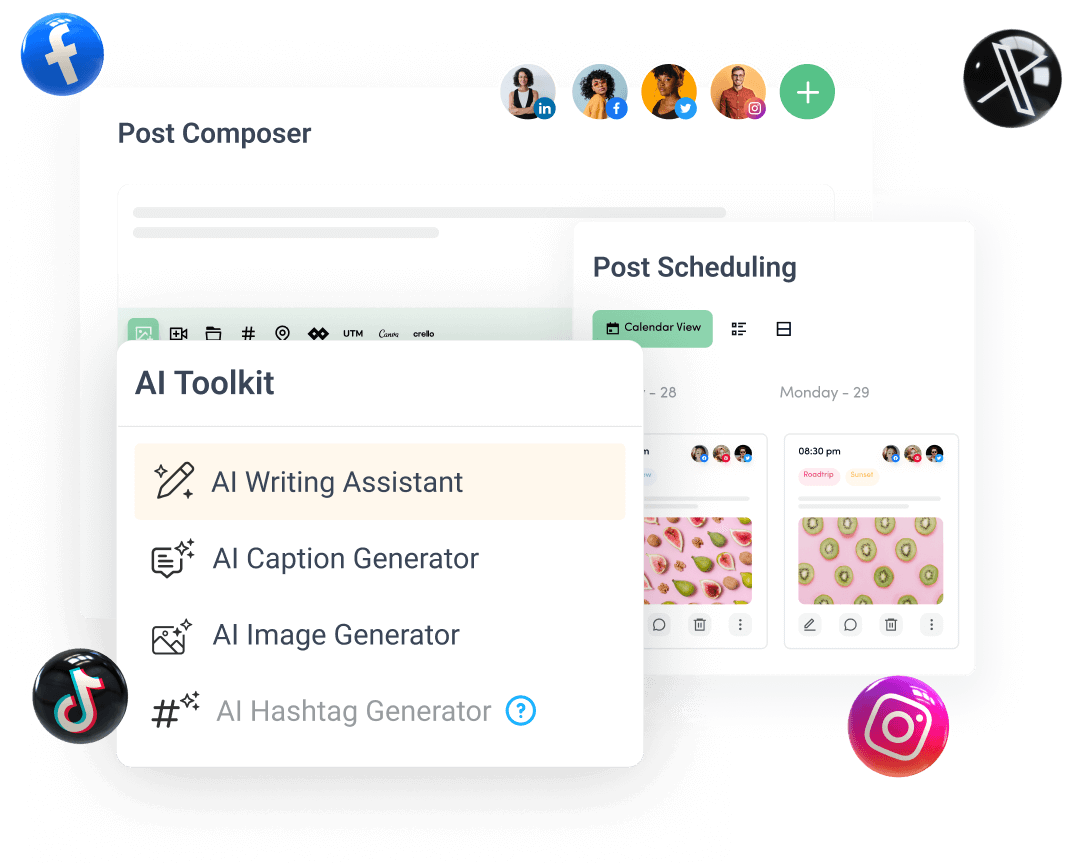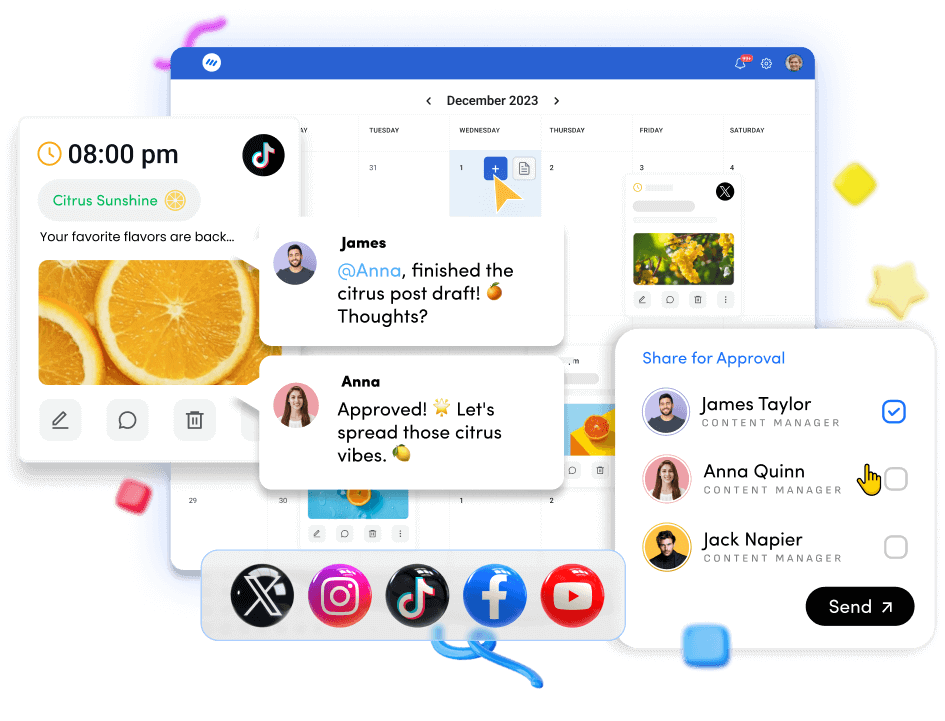🚀 Introducing Contentpen – Your AI-Powered content assistant!Join the waitlist.
Approval workflow

What is an approval workflow?
An approval workflow is a systematic process where content must be reviewed and approved by designated stakeholders before publication. In social media management, approval workflows ensure quality control, brand consistency, and compliance with organizational guidelines by creating structured paths for content to move from creation to publication.
Why approval workflows matter for social media management?
Implementing a structured approval process is essential for brands and agencies managing social media content at scale.
A well-designed approval workflow helps maintain brand voice consistency, prevents errors, and enables collaboration among team members with different roles and responsibilities.
Key benefits of approval workflows
A robust approval workflow offers several advantages for marketing teams and agencies:
- Quality assurance: Ensures content is error-free, on-brand, and strategically aligned before reaching your audience
- Risk mitigation: Reduces the likelihood of publishing inappropriate or inaccurate content that could damage brand reputation
- Accountability: Creates clear roles and responsibilities for who creates, reviews, and approves content
- Efficiency: Streamlines the content review process, reducing bottlenecks and delays
- Compliance: Helps ensure adherence to industry regulations, particularly important for healthcare, financial services, and other regulated sectors
Types of approval workflows
Different organizations require different approval structures based on their size, industry, and content needs.
Linear approval workflow
In a linear workflow, content moves sequentially through predefined stages. For example:
- Content creator drafts post
- Manager reviews for strategic alignment
- Legal team checks for compliance issues
- Client or executive gives final approval
- Content is scheduled for publication
This structured approach works well for regulated industries or when multiple stakeholders must review content.
Collaborative approval workflow
Collaborative workflows allow multiple reviewers to provide feedback simultaneously:
- Content creator shares draft with all stakeholders
- Team members review and provide feedback concurrently
- Creator incorporates feedback
- Final approver gives the green light
- Content is scheduled for publication
This approach often leads to faster turnaround times but may result in conflicting feedback.
Role-based approval workflow
Role-based workflows assign approval responsibilities based on content type or channel:
- Channel-specific approvals: Different team members approve content for different platforms (e.g., LinkedIn vs. TikTok)
- Content-type approvals: Various stakeholders approve different content formats (e.g., video content vs. text posts)
- Campaign-based approvals: Specific teams handle approvals for particular marketing campaigns
Creating an effective social media approval workflow
Establishing a streamlined approval process requires careful planning and the right tools. Following a step-by-step guide can help agencies implement efficient approval systems for their clients.
Define clear roles and responsibilities
Start by determining who needs to be involved in the approval process:
- Content creators: Team members who draft posts and create visual assets
- Reviewers: Subject matter experts who provide feedback on content accuracy and quality
- Approvers: Decision-makers with final publishing authority
- Publishers: Team members responsible for scheduling approved content
Establish approval criteria
Set clear standards for what constitutes "approved" content:
- Brand voice and tone: Does the content align with your established brand voice?
- Visual consistency: Do images and videos adhere to brand guidelines and social media image sizes?
- Strategic alignment: Does the content support current marketing objectives?
- Accuracy: Is all information factually correct and up-to-date?
- Compliance: Does the content meet regulatory requirements for your industry?
Implement a social media approval workflow tool
The right technology makes managing approvals significantly easier. ContentStudio's social media approval workflow streamlines the entire process, allowing teams to:
- Create structured approval paths for different content types
- Track content status from creation to publication
- Provide feedback directly on content
- Set automatic reminders for pending approvals
- Maintain a complete history of edits and approvals
Best practices for social media approval workflows
Optimize your approval process with these proven strategies:
Document your workflow
Create clear documentation of your approval process, including:
- Step-by-step workflows for different content types
- Expected turnaround times for each stage
- Contingency plans for urgent content needs
- Templates for common content formats
Establish reasonable timelines
Balance thoroughness with efficiency:
- Standard content: Allow 1-3 business days for full approval
- Campaign content: Schedule reviews 1-2 weeks before launch
- Time-sensitive content: Create an expedited approval path for urgent posts
- Regular content cadence: Schedule social media posts in batches to streamline approvals
Create content templates
Develop pre-approved templates for recurring content types:
- Product announcements
- Industry news shares
- Customer testimonials
- Holiday greetings
- Event promotions
Templates speed up approvals and maintain consistency while still allowing for customization.
Train your team
Ensure everyone understands:
- How to use your approval workflow software
- Their specific roles and responsibilities
- Content standards and guidelines
- Common reasons for content rejection
- How to provide constructive feedback
Challenges in social media approval workflows
Even well-designed approval processes face common challenges:
Bottlenecks and delays
When approvers become bottlenecks, try:
- Setting up automatic reminders for pending approvals
- Creating service-level agreements for review timeframes
- Implementing escalation procedures for delayed approvals
- Using social media management tools with built-in notification systems
- Establishing clear approval processes that streamline workflows
- Implementing efficient team collaboration practices
Balancing speed and quality
To maintain content quality while meeting tight deadlines:
- Develop a content calendar to plan ahead
- Create an expedited approval path for time-sensitive content
- Use content batching to review multiple posts at once
- Implement automated quality checks where possible
- Utilize social media scheduling tools to prepare content in advance
- Create content pillars to streamline content creation
Managing multiple stakeholders
When numerous people need to approve content:
- Clearly define who has final approval authority
- Consider parallel rather than sequential reviews when appropriate
- Use collaborative tools that allow stakeholders to see each other's feedback
- Implement client management features for agency-client approvals
- Develop social media management strategies for agencies
- Create efficient workspaces for team collaboration
- Implement social media management tools for agencies
How to streamline social media approvals with ContentStudio
ContentStudio's approval workflow simplifies the entire process:
- Create structured workflows: Build custom approval paths based on content type, channel, or campaign
- Assign team roles: Define clear responsibilities for each team member
- Provide contextual feedback: Comment directly on content elements
- Track approval status: Monitor where content stands in the approval pipeline
- Maintain approval history: Keep records of all edits and approvals for accountability
- Manage client relationships: Use client management tools to organize approvals by account
- Handle multiple accounts: Manage multiple social media accounts from a central location
This integrated approach makes managing social media content more efficient while maintaining quality standards.
Conclusion
A well-designed social media approval workflow balances quality control with efficiency, ensuring your brand maintains a consistent voice while publishing timely content.
By establishing clear roles, implementing the right tools, and continuously optimizing your process, you can create an approval system that enhances your social media management without creating unnecessary bureaucracy.
Whether you're an agency handling bulk scheduling for multiple clients or an in-house team coordinating various stakeholders, an effective approval workflow is essential for social media success.

Create, plan, schedule, and publish posts on all social media networks




